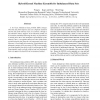Free Online Productivity Tools
i2Speak
i2Symbol
i2OCR
iTex2Img
iWeb2Print
iWeb2Shot
i2Type
iPdf2Split
iPdf2Merge
i2Bopomofo
i2Arabic
i2Style
i2Image
i2PDF
iLatex2Rtf
Sci2ools
ICPR
2006
IEEE
2006
IEEE
Hybrid Kernel Machine Ensemble for Imbalanced Data Sets
A two-class imbalanced data problem (IDP) emerges when the data from majority class are compactly clustered and the data from minority class are scattered. Though a discriminative binary Support Vector Machine (SVM) can be trained by manually balancing the data, its performance is usually poor due to the inadequate representation of the minority class. A recognition-based one-class SVM can be trained using the data from the well-represented class only. However, it is not highly discriminative. Exploiting the complementary natures of the two types of SVMs in an ensemble can bring benefits from both worlds in addressing the IDP. Experimental results on both artificial and real benchmark data sets support the feasibility of our proposed method.
Computer Vision | Discriminative Binary Support | ICPR 2006 | Imbalanced Data Problem | Real Benchmark Data |
| Added | 09 Nov 2009 |
| Updated | 09 Nov 2009 |
| Type | Conference |
| Year | 2006 |
| Where | ICPR |
| Authors | Kap Luk Chan, Peng Li, Wen Fang |
Comments (0)

